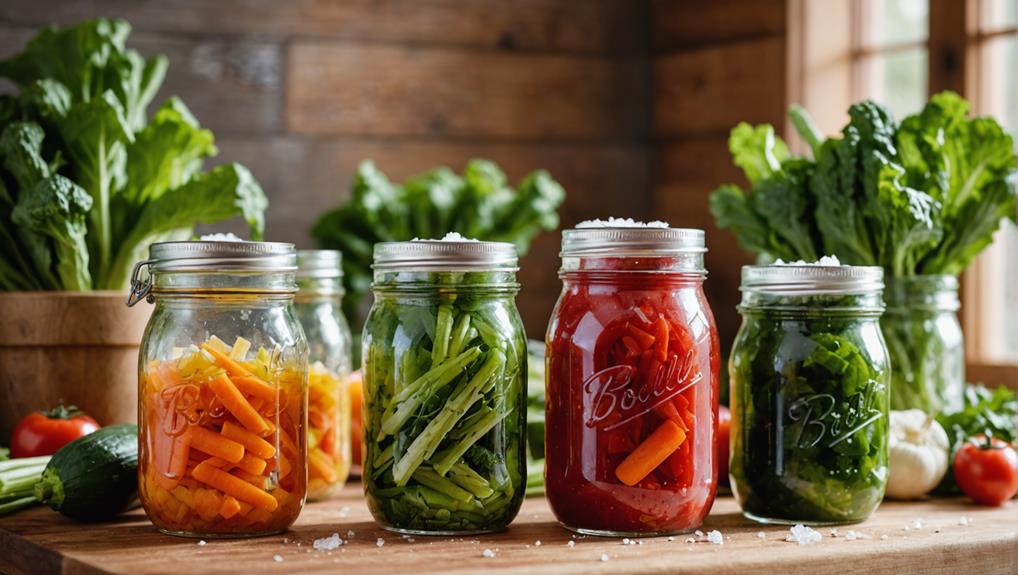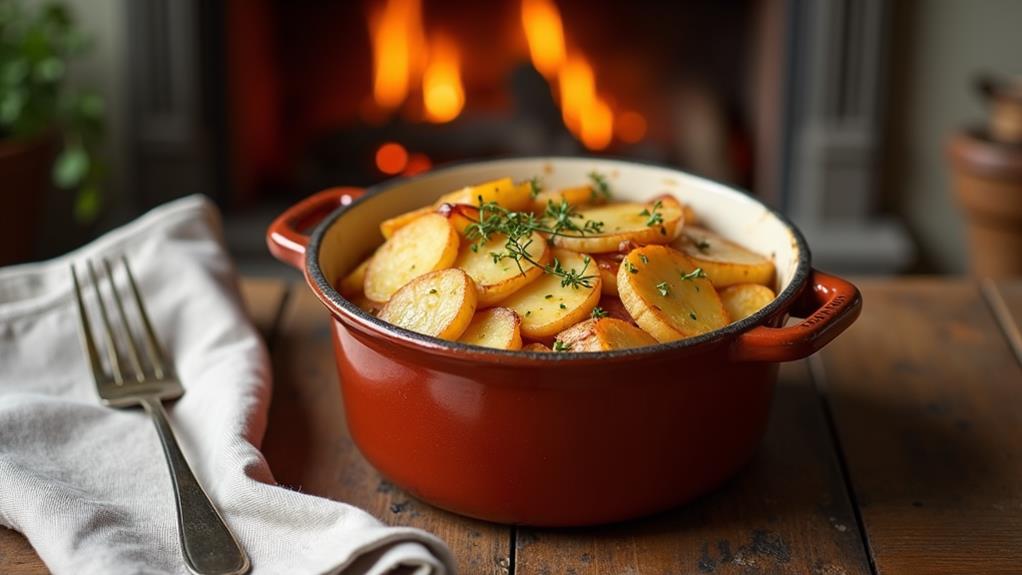Dive into the secret world of vegetable fermentation to unleash tantalizing flavors at home. You'll harness the power of beneficial bacteria, primarily Lactobacillus, to transform fresh produce into probiotic-rich delicacies. Start by selecting crisp, organic vegetables and submerging them in a salt brine solution. This anaerobic environment promotes lacto-fermentation, enhancing flavors and preserving nutrients. Use clean, non-metallic containers and proper weights to keep vegetables submerged. Monitor the process regularly, tasting to track flavor development. With time and practice, you'll master the art of creating unique, tangy, and healthful fermented vegetables. Unlock a world of culinary possibilities and gut-health benefits as you explore this ancient preservation technique.
The Science Behind Lacto-fermentation
Almost all home vegetable fermentation relies on the fascinating process of lacto-fermentation. This innovative method harnesses the power of beneficial bacteria, primarily Lactobacillus, to transform your ordinary vegetables into tangy, probiotic-rich delights.
As you embark on your fermentation journey, you'll witness the magic of these microscopic helpers converting sugars into lactic acid, creating that distinctive flavor you crave.
To kickstart this process, you'll need to create an anaerobic environment. By submerging your vegetables in a brine solution, you're not only preventing harmful bacteria and molds from growing but also drawing out moisture from the veggies.
This salt-induced osmosis contributes to that satisfying crunch you'll experience in your final product.
The duration of your fermentation adventure can be tailored to your taste preferences. Warmer temperatures will accelerate the process, resulting in a more pronounced acidity, while cooler conditions will yield milder flavors over an extended period.
As you experiment with different fermentation times and temperatures, you'll unlock a world of flavors and textures, all while boosting your gut health with live probiotics.
Choosing the Perfect Vegetables
When selecting vegetables for fermentation, you'll want to focus on the best varieties, prioritize freshness and quality, and prepare them properly.
Start by choosing harder vegetables like carrots, cabbage, and radishes, which maintain their crunch and ferment well.
Always opt for fresh, organic produce that's free from blemishes, as this ensures a successful fermentation process and enhances the final flavor of your fermented vegetables.
Best Fermenting Vegetable Varieties
As you embark on your fermentation journey, selecting the right vegetables is crucial for success. Cruciferous vegetables like cabbage, kale, and broccoli are excellent choices for fermented vegetables, as their high natural sugar content promotes the growth of beneficial bacteria.
When exploring different varieties, you might consider adding elements from other world cuisines, such as Sweet Potato and Black Bean Tacos that celebrate seasonal ingredients and complex flavors. These versatile options have been used in different cultures for centuries, creating iconic dishes like sauerkraut and kimchi.
Root vegetables, such as carrots and beets, offer a delightful crunch when fermented, while cucumbers remain a popular pickling staple due to their ability to absorb flavors.
To add depth and complexity to your ferments, consider incorporating garlic and chili peppers. These powerhouse ingredients not only enhance taste but also provide additional health benefits.
For the adventurous fermenter, leafy greens like spinach and Swiss chard present an exciting challenge. While they can create unique ferments, their high moisture content requires careful monitoring to prevent spoilage.
Freshness and Quality Matters
The cornerstone of successful vegetable fermentation lies in selecting fresh, high-quality produce. When it comes to creating tantalizing fermented flavors at home, freshness and quality matters more than you might think.
Opt for organic or locally sourced vegetables whenever possible, as they're less likely to contain harmful pesticides that can hinder the fermentation process. You'll want to choose vegetables that are firm, crisp, and free from bruises or signs of decay. These imperfections can lead to undesirable flavors and spoilage during fermentation.
To maximize health benefits and flavor, consider selecting seasonal vegetables at their peak. They typically offer the best nutritional content and taste, making them ideal candidates for fermentation.
When preparing your chosen veggies, wash them thoroughly but resist the urge to peel them. The natural bacteria on their skins play a crucial role in kickstarting the fermentation process.
Preparing Vegetables Properly
Selecting the right vegetables is crucial for successful fermentation. You'll want to choose fresh, high-quality produce with optimal natural sugars and moisture content. For instance, hard vegetables like carrots, radishes, and cucumbers are ideal due to their firm texture, which helps maintain crunchiness after fermentation.
Incorporating fresh, seasonal ingredients, like those used in Harvest Vegetable Soup, can also add intriguing layers of flavor and depth to your fermented creations. Avoid overripe or damaged vegetables, as they can introduce unwanted bacteria and compromise the safety of your fermented creation.
When preparing vegetables for fermentation, consider these key points:
- Cut vegetables into uniform sizes for even fermentation and optimal brine absorption
- Experiment with seasonal or locally sourced produce for unique flavor profiles
- Combine different vegetables to create exciting taste combinations
Essential Equipment for Fermentation
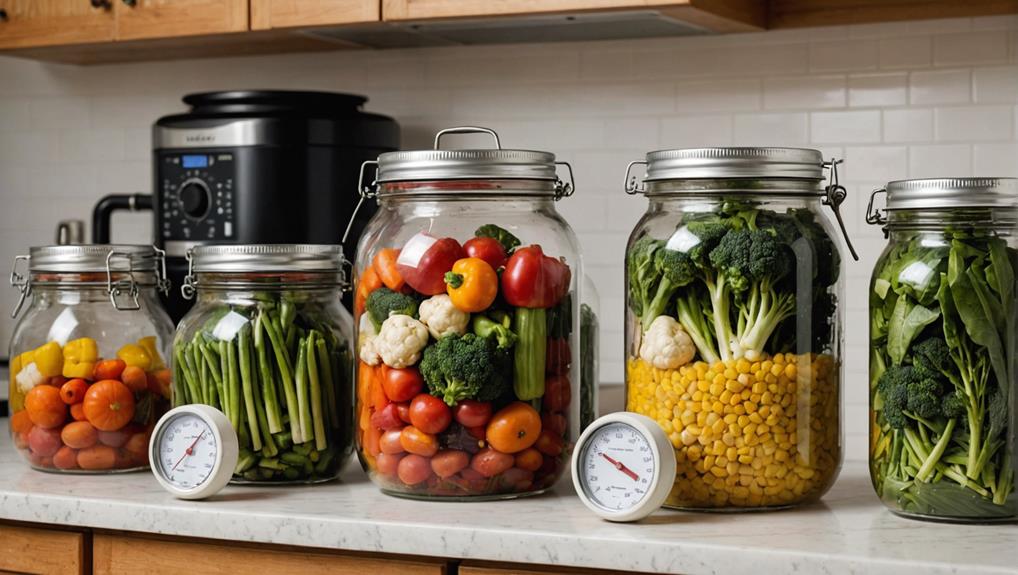
When it comes to fermenting vegetables at home, you'll need to choose the right equipment to ensure success.
Start by selecting heavy ceramic crocks or glass containers with wide mouths as your fermentation vessels, as these materials resist corrosion and allow for proper gas exchange.
To keep your vegetables fully submerged during the fermentation process, you'll want to use a plate weighted down by a water jug, which prevents mold growth and maintains the necessary anaerobic conditions.
Choosing Fermentation Vessels
Choosing the right vessel is crucial for successful vegetable fermentation at home. For optimal results, opt for heavy ceramic crocks or wide-mouthed glass containers. These vessels promote proper air circulation and safeguard against harmful bacteria contamination, ensuring a high-quality final product.
Avoid metal containers, as the salt and acids in the fermentation process can corrode them, potentially compromising your ferment's safety.
To maintain the integrity of your fermentation, consider these key factors:
- Cleanliness: Sanitize your vessel thoroughly before use
- Submersion: Keep vegetables submerged using weights like plates and water jugs
- Monitoring: Regularly check for surface mold and remove any dry, exposed layers
When selecting your fermentation vessel, prioritize materials that won't react with the acidic environment. Glass and ceramic are ideal choices, as they're inert and easy to clean.
Remember, the right vessel plays a significant role in the success of your fermentation process. By choosing wisely, you'll create an environment that fosters beneficial bacteria growth and results in flavorful, probiotic-rich vegetables.
Embrace the innovation of home fermentation and unlock a world of tantalizing flavors right in your kitchen.
Tools for Submerging Vegetables
Now that you've selected the perfect vessel, let's focus on keeping your vegetables submerged during fermentation. Submersion is crucial to prevent mold growth and ensure a successful ferment. You'll need some innovative tools to achieve this.
One effective method is to place a clean plate directly on top of your vegetables. To add weight, you can use a water-filled jug or a sealed bag as a makeshift weight. This simple yet ingenious approach keeps your veggies safely below the brine's surface, away from the presence of oxygen that can lead to spoilage.
For those seeking a more specialized solution, consider investing in fermentation weights. These glass or ceramic discs are designed to fit snugly inside your vessel, providing consistent pressure to keep vegetables submerged.
Remember to regularly monitor your ferment, removing any surface mold and discarding exposed layers to maintain quality.
To add a splash of creativity, you can also use large, clean leaves like cabbage or grape leaves as a natural barrier. Place them over your vegetables before adding weights to create an extra layer of protection against air exposure.
Crafting the Ideal Brine
Crafting the ideal brine is a crucial step in successful vegetable fermentation. To get the salt right, start with a ratio of 3 tablespoons of salt per 5 pounds of vegetables. It's essential to use non-iodized salt, such as sea salt or kosher salt, as iodized varieties can hinder the process of fermenting and negatively affect flavors.
You'll want to fully submerge your vegetables in this saltwater solution to prevent air exposure and potential spoilage.
As you embark on your fermentation journey, keep these key points in mind:
- The brine may become cloudy, which is a normal sign of active fermentation
- Flavor will intensify and become tangier over time
- You can adjust salt concentration to influence crunchiness and taste
Don't be afraid to experiment with your brine's salt levels to personalize your ferments.
Remember, the brine plays a vital role in drawing out moisture from the vegetables and promoting the growth of beneficial bacteria.
Proper Vegetable Packing Techniques
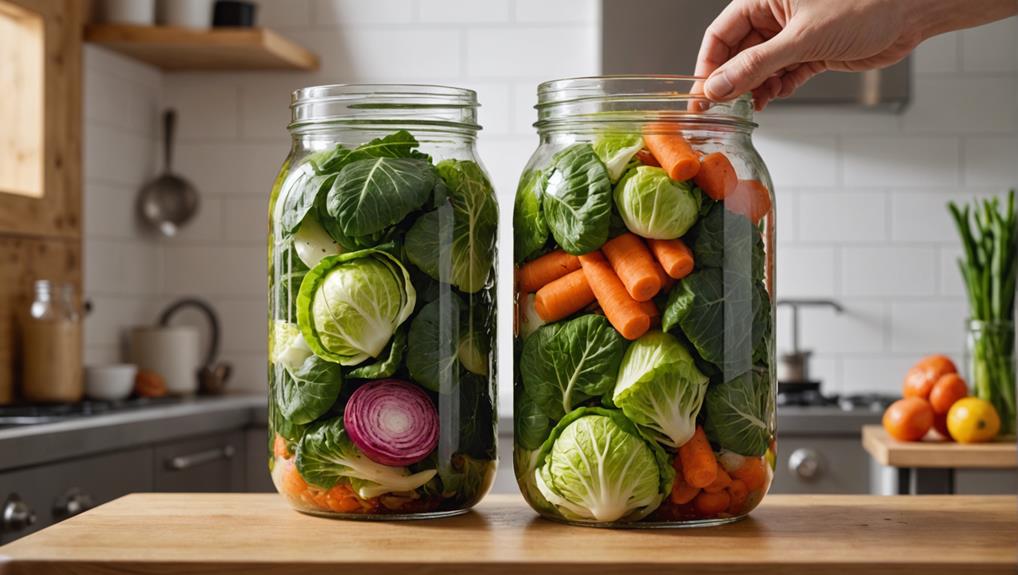
In line with the importance of proper brine preparation, mastering vegetable packing techniques is crucial for successful fermentation. To maximize flavor and ensure optimal results, you'll want to start by cutting or shredding your vegetables. This increases their surface area, promoting beneficial bacterial growth and moisture release.
As you add vegetables to your fermentation vessel, make sure to pack them tightly. This minimizes air pockets that can lead to mold growth and spoilage. Press down firmly on each layer to achieve a snug fit.
Don't forget to leave about 1-2 inches of headspace at the top to accommodate expansion during fermentation.
To keep your vegetables fully submerged, use a weight such as a clean plate or water-filled jar. This prevents exposure to air and ensures even fermentation throughout.
As the process progresses, you'll need to monitor your ferment regularly. If necessary, adjust the packing by pushing down on the vegetables or adding more brine to maintain submersion.
Monitoring Your Fermentation Process
Once your vegetables are properly packed and submerged, it's crucial to monitor the fermentation process closely. Regularly inspect your vessel for signs of mold or dry layers, removing any surface growth to maintain quality. Taste your ferment at various intervals to track flavor progression and determine your preferred level of acidity. Remember, longer fermentation times yield tangier flavors, allowing you to customize your creations.
Keep these key points in mind when monitoring your fermentation process:
- Cloudy brine is normal and indicates active bacterial growth
- Temperature affects fermentation speed; warmer environments accelerate the process
- Ensure vegetables remain fully submerged in brine to prevent spoilage
As you explore the world of fermentation, you'll discover that recipes that call for specific fermentation times are just starting points. Your personal taste preferences and environmental factors will ultimately guide your fermentation journey.
Don't be afraid to experiment with different durations to achieve unique flavor profiles. By closely monitoring your ferments, you'll develop a keen sense of when they've reached their peak, allowing you to create consistently delicious and innovative fermented vegetables that will tantalize your taste buds and impress your friends.
Flavor Development and Enhancement
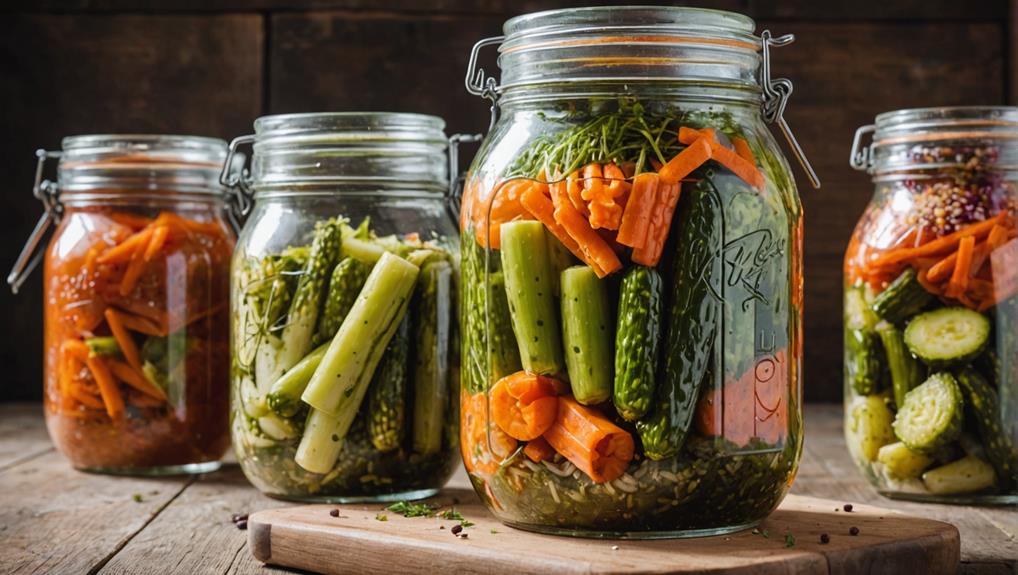
As you become familiar with monitoring your ferments, you'll discover the exciting world of flavor development and enhancement. The interplay of time, temperature, and beneficial bacteria and yeast creates a symphony of tastes that'll tantalize your palate.
Longer fermentation periods yield tangier, more complex flavors, while shorter durations result in milder profiles. You're in control of this flavor journey, so don't hesitate to taste regularly and adjust as needed.
Temperature is your secret weapon in flavor development. Warmer environments accelerate fermentation, intensifying flavors more quickly. By carefully managing temperature, you can craft the perfect balance of tang and complexity.
Lactobacillus, the star player in vegetable fermentation, produces lactic acid that not only preserves your veggies but also contributes to their distinctive zesty taste.
To truly unleash your creativity, experiment with spices and additional ingredients. These additions can transform simple ferments into gourmet creations, allowing you to develop unique flavor profiles that'll wow your taste buds.
Storing and Enjoying Fermented Vegetables
You've successfully fermented your vegetables, and now it's time to store and savor your creations. To preserve your tangy treasures, store them in airtight containers in the refrigerator. This innovative approach will extend their shelf life for several months, maintaining their unique flavors and textures.
Ensure your vegetables remain fully submerged in their brine to prevent spoilage and mold growth.
As you embark on your fermentation journey, consider these exciting possibilities:
- Experiment with adding wine vinegar to your ferments for a complex flavor profile
- Incorporate starch-rich vegetables like carrots or beets to create a satisfying texture
- Blend fermented vegetables into dips or spreads for a probiotic-packed snack
Regularly sample your ferments to track their evolving flavors and determine your preferred taste.
When serving, pair them with complementary dishes to enhance their tangy complexity. Try adding them to salads, grain bowls, or as toppings for sandwiches and tacos.
Always inspect your fermented vegetables before consuming, discarding any that show signs of spoilage.
Frequently Asked Questions
How to Make Fermented Veggies at Home?
You'll need to master brine ratios and choose proper fermentation vessels. Chop veggies, submerge them in salt water, and let beneficial bacteria work their magic. Experiment with flavors and fermentation times to create your unique probiotic-rich creations.
What Are the Top 10 Fermented Foods?
Like a probiotic party in your gut, the top 10 fermented foods include kimchi varieties, sauerkraut, kombucha (with its myriad benefits), miso, yogurt, kefir, tempeh, natto, sourdough bread, and pickles. You'll revolutionize your microbiome with these innovative edibles!
What Foods Cause Fermentation in the Gut?
You'll find that high-fiber foods, cruciferous veggies, and resistant starches cause fermentation in your gut. They're fuel for your gut bacteria, boosting digestive health. Even fermented foods and some sweeteners can spark this innovative microbial process within you.
Are Fermented Vegetables Good for You?
Yes, fermented vegetables are excellent for you! They're packed with health benefits, thanks to their probiotic properties. You'll boost your gut health, enhance nutrient absorption, and potentially improve your immune system. They're an innovative way to revolutionize your diet.
Final Thoughts
You've now unlocked the tangy, vibrant world of vegetable fermentation. Like an artist with a palette of flavors, you're ready to create your own probiotic masterpieces. Armed with science, technique, and a dash of patience, you'll transform humble vegetables into complex, mouth-watering delicacies. Remember, each batch is a unique journey of taste and texture. So, embrace the process, trust your senses, and don't be afraid to experiment. Your kitchen's about to become a wonderland of bubbling, aromatic jars brimming with health and flavor.

